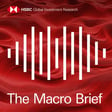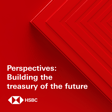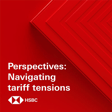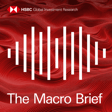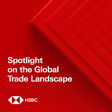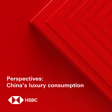Become a Creator today!Start creating today - Share your story with the world!
Start for free
00:00:00
00:00:01

The ESG Brief - Retail supply chains, carbon pricing in China, and boardroom diversity
In this episode we explore the use of technology to improve the transparency of the retail supply chain with Amy Tyler. Jing Liu provides an update on the use of carbon pricing in China to jumpstart green investment, and Yaryna Kobel looks at boardroom diversity.
To stay connected and to access free to view reports and videos from HSBC Global Research click here.
Hosted on Acast. See acast.com/privacy for more information.
Transcript
Introduction to HSBC Global Viewpoint
00:00:00
Speaker
This is HSBC Global Viewpoint, your window into the thinking, trends and issues shaping global banking and markets.
00:00:09
Speaker
Join us as we hear from industry leaders and HSBC experts on the latest insights and opportunities for your business.
00:00:16
Speaker
Thank you for listening.
Launch of ESG Brief for 2022
00:00:27
Speaker
Hi, everybody.
00:00:27
Speaker
Welcome to the first edition of the ESG Brief for 2022, your window on the views of the environmental, social, and governance team here at HSBC Global Research.
00:00:37
Speaker
I'm your host, Jack Reed.
Role of Technology in Retail Supply Chains
00:00:39
Speaker
We'll be talking today with analyst Amy Tyler about how drones and blockchain can help cut through the complexities of the retail supply chain.
00:00:47
Speaker
We're looking at a new report from HSBC on carbon pricing in China, and we'll be reviewing some of the work we've done on the state of boardroom diversity in 24 markets around the world.
00:01:01
Speaker
Remember, all the disclosures and disclaimers associated with this podcast must be read through the link on your media player.
00:01:08
Speaker
And with that, a welcome to Amy Tyler.
00:01:11
Speaker
Thank you very much.
00:01:13
Speaker
Amy, the team has written a lot about the retail supply chain.
00:01:16
Speaker
Give us a brief picture on why this matters so much.
00:01:20
Speaker
The retail supply chains are vast and very complicated.
00:01:23
Speaker
And much of the work is outsourced and subcontracted all around the world, with materials coming from numerous locations where there is a tendency to be less transparent.
00:01:33
Speaker
And most retailers therefore not fully disclosing their supply chains.
00:01:37
Speaker
So for example,
00:01:39
Speaker
in the fashion transparency index, in 2020, only 40% of 250 retailers disclose their first tier suppliers, which is the suppliers they're in contact with.
00:01:49
Speaker
This rose to 47% in 2021.
00:01:50
Speaker
However, this is still a long way to go.
00:01:54
Speaker
So the main problem here is the lack of accountability.
00:01:57
Speaker
It creates problems such as poor governance and social risks, including human rights and working conditions as well.
00:02:04
Speaker
And also the inability to understand a company's environmental footprint, which are key ESG metrics.
00:02:11
Speaker
So the real importance to investors is that we're seeing brands and the headlines being linked to these poor practices.
00:02:18
Speaker
And with the number of regulations that are on the rise, this runs the risk of fines from these regulations and more negative coverage for the lack of supply chain transparency.
00:02:28
Speaker
Also as well, we're seeing the importance of sustainability data and ESG targets making traceability a key aspect of a company's sustainable practices.
00:02:38
Speaker
Now your report looks at how various technologies are being put to work to make that supply chain more transparent.
00:02:44
Speaker
You talk about developments around element analysis.
00:02:47
Speaker
What's going on there?
00:02:49
Speaker
So we find this one the most interesting of all the technologies, and it involves taking a sample of products and creating a chemical fingerprint, which then determines the location of the fiber.
00:02:59
Speaker
And this is done by comparing it with samples taken from the location it's claimed to be from.
00:03:04
Speaker
The benefit of this is that retailers can then confirm a product's origin
00:03:08
Speaker
and it helps reduce the risk of counterfeit labelings through the supply chain.
00:03:12
Speaker
It can also be applied to other industries as well, including food.
00:03:16
Speaker
And as the database grows, all the testing and sampling, the ease of identification grows.
00:03:23
Speaker
And blockchain?
00:03:25
Speaker
Yeah, so this can comprise a list of records that is on this decentralized system and it really helps the retail industry increase its transparency by bringing the ability to map the entire journey the product goes through from this raw material stage to the finished goods.
00:03:41
Speaker
And the other technologies as well, such as Internet of Things and AI, really complement this blockchain by adding in sensors and traceability to increase the accuracy of this data.
00:03:51
Speaker
And the report also talks about drones.
00:03:53
Speaker
I mean, presumably this is some kind of literally top-down view of the supply chain.
00:03:59
Speaker
What are they for exactly that can't be found by other means?
00:04:04
Speaker
These drones involve integrating the technology into the first stage of the supply chain, and it allows for the monitoring and data collection improvements for the crops, so such as cotton, for example, and also the ability to manage and regulate these environmental factors we talk about so often, such as water and pesticides.
00:04:22
Speaker
And this data can be passed on to the retailer as it's collected by the drone and sensors and cameras.
00:04:27
Speaker
And then they have a clearer picture of the raw material that goes into their final product, improving the transparency overall.
00:04:34
Speaker
So it literally is a top down view.
00:04:36
Speaker
Yes.
00:04:37
Speaker
So all this sounds great for supply chain transparency, but potentially hugely expensive.
00:04:41
Speaker
How advanced are retailers in embracing these technologies and who are they?
00:04:48
Speaker
So as you say, very costly.
00:04:50
Speaker
So these technologies aren't commercially viable as of yet, and only really the largest retailers and luxury brands are currently investing.
00:04:58
Speaker
So for example, blockchain and AI are one of the most invested at the moment.
00:05:02
Speaker
And they're definitely a pilot trial and error stages.
00:05:05
Speaker
However, this is positive because as these retailers share many of the same suppliers and raw material producers,
00:05:11
Speaker
It's expected that these practices will then filter into the broader market, especially as the expectation from consumers and regulators for a transparent supply chain improves.
00:05:21
Speaker
Amy, that's a great summary of the report.
00:05:23
Speaker
Thanks.
00:05:24
Speaker
Thank you very much.
China's Carbon Pricing and Green Investment
00:05:28
Speaker
Still to come, boardroom diversity and biodiversity.
00:05:31
Speaker
But first, our producer in Hong Kong, Graham Mackay, has been looking at a new report from our China economics team on carbon pricing as a means to accelerate green investment in China.
00:05:43
Speaker
He spoke with economist Jing Liu.
00:05:45
Speaker
Jing, welcome to the podcast.
00:05:47
Speaker
Thank you very much for having me.
00:05:50
Speaker
So we know that the transition to green energy is a big part of the long-term economic plan for China.
00:05:57
Speaker
Just give us a sense of where we are now along that timeline.
00:06:01
Speaker
Sure.
00:06:01
Speaker
So after President Xi Jinping made the commitment for the 2030 carbon peak and 2060 carbon neutrality, I think basically we have seen the momentum picking up.
00:06:13
Speaker
And now the central government has issued different documents trying to plot the official roadmap.
00:06:22
Speaker
towards that.
00:06:22
Speaker
That involves the changes in different sectors such as the power sector, the industrial sector, the transportation, buildings, etc.
00:06:32
Speaker
And in terms of public versus private sector, where's the green investment currently coming from?
00:06:38
Speaker
So far, we have seen the state-owned enterprises taking the lead.
00:06:42
Speaker
So basically, in the case of China, actually the power and industrial sector account for about 80% of the emissions.
00:06:51
Speaker
So it's essential to have them
00:06:54
Speaker
going through the green transition.
00:06:56
Speaker
For these sectors, the state-owned enterprises have a larger share.
00:07:01
Speaker
So very naturally, we have seen, for example, the state grid announced that they are going to invest 500 billion renminbi just for this year in order to upgrade the power grid together with building some energy storage.
00:07:17
Speaker
And elsewhere in the heavy industry sector, we have seen similar changes as well.
00:07:23
Speaker
Okay, so SOE's leading the charge towards the greener economy in China.
00:07:28
Speaker
POE's lacking behind somewhat, but that's where carbon pricing comes in, according to your latest report.
00:07:34
Speaker
Yes, definitely.
00:07:35
Speaker
So basically for the SOEs, it's relatively easier for the government to give them a green light and help them trying to lead the investment.
00:07:45
Speaker
But for the private participation, which is essential, not just in China, but globally for the climate ambition, we have to think that they can participate more voluntarily.
00:07:56
Speaker
By that we mean, if we can design this system in a way that it's cheaper for them to invest in
00:08:03
Speaker
the transition, then to continue their emission, then that will naturally bring them in the game.
00:08:10
Speaker
Okay, so how do you think China needs to design the system in order to incentivize more private sector investment?
00:08:17
Speaker
Sure.
00:08:18
Speaker
So last year in July, we've seen that China launched the National Emission Trading Scheme.
00:08:26
Speaker
This one is now concurrently running together with eight pilot regional ETSs.
00:08:33
Speaker
And as our HSBC ESG analysts forecasted back in 2017, that's going to be the case.
00:08:41
Speaker
Together with even smaller companies probably will be brought under the carbon taxes down the road.
00:08:49
Speaker
Right.
00:08:50
Speaker
And if we were to look beyond China, Jing, let's say to Europe, where we've seen carbon prices rise quite dramatically in recent times, and there's a much longer established emissions trading scheme, which they're now several stages into, where is China by comparison?
00:09:05
Speaker
And what could it take from the example set by the EU?
00:09:10
Speaker
Wow, that's a great question.
00:09:11
Speaker
Actually, in our report, we refer to the EU ETS.
00:09:15
Speaker
That is the oldest running scheme and also become to be more and more important.
00:09:21
Speaker
In China's case, the first stage of the launch only covers the power sector.
00:09:28
Speaker
And at the same time, the
00:09:30
Speaker
quota or allowance is allocated freely.
00:09:34
Speaker
So, so far we don't see much trading.
00:09:37
Speaker
We don't see, you know, a high enough carbon prices.
00:09:40
Speaker
Probably in the case of China now is not even 10% of the carbon prices in Europe.
00:09:47
Speaker
But over time, that needs to change.
00:09:50
Speaker
I think now what we're talking about is a transition from the free allocation to auction-based, which also ideally we will see the change from the currently it's intensity-based to over time it's going to be a mass-based.
00:10:07
Speaker
That means the total amount of emission.
00:10:09
Speaker
If those things will be implemented in place, then that could be more meaningful for the companies to start to change their behavior.
00:10:22
Speaker
All right.
00:10:22
Speaker
Well, clearly a developing story and one that we will continue to monitor.
00:10:26
Speaker
Jing, thank you very much again for joining us.
00:10:28
Speaker
Thank you.
Boardroom Diversity Trends
00:10:35
Speaker
We turn now to diversity in the boardroom with governance analyst Yurina Kobol.
00:10:41
Speaker
Yurina published a report last month in which she looked at trends across 24 markets.
00:10:47
Speaker
So when it comes to governance in the boardroom and what investors expect, where has the focus been until now?
00:10:55
Speaker
Yeah, we have seen actually a lot of focus on diversity recently, and most of the diversity considerations and efforts have been focused on gender and ethnic diversity.
00:11:07
Speaker
As you have mentioned, we looked at 24 markets and 21 of them, they actually provide for some sort of gender diversity disclosure requirements or recommendation for boards.
00:11:20
Speaker
And 18 of them have set gender diversity quotas or targets.
00:11:25
Speaker
Actually 19 now because Hong Kong in December last year introduced a new requirement for boards of listed companies to have at least one director of different gender by 2024.
00:11:40
Speaker
And we also have seen developments on ethnic diversity.
00:11:44
Speaker
For example, the Financial Conduct Authority, the regulator in the UK, proposed a new rule for listed companies to disclose on a compliant and explained basis whether they meet the new diversity targets.
00:11:59
Speaker
And one of them is actually to have at least one member from non-white ethnic minority background on the board.
00:12:08
Speaker
And how do you measure progress on these points?
00:12:13
Speaker
Yeah, measuring the progress is actually the key here, I think.
00:12:17
Speaker
And gender diversity is one of those dimensions of diversity which are probably most easily measurable.
00:12:27
Speaker
And in the markets we looked at, they are also something that's required to be reported.
00:12:33
Speaker
And we see great progress among the largest listed companies in Norway, France, Italy and the UK.
00:12:41
Speaker
So they all report that more than 30% of all board seats are actually held by women.
00:12:48
Speaker
At the same time, we see that in Saudi Arabia, UAE, Mexico, Russia and Korea, women representation on the boards of the largest companies is below 10%.
00:13:00
Speaker
So you're picking up some big differences there in gender representations between companies in the developed and emerging markets.
00:13:07
Speaker
Your report also takes the whole question of diversity quite a bit further in terms of what you refer to as cognitive diversity in the boardroom.
00:13:16
Speaker
What do you mean by that?
00:13:18
Speaker
Yes, we look not only at ethnic and gender diversity, which we believe are really important and we welcome the progress made.
00:13:25
Speaker
However, to improve company performance, we think that boards need to have cognitive diversity in the boardroom.
00:13:33
Speaker
And this is how board members think, reason, solve problems.
00:13:38
Speaker
We think cognitive diversity in the boardroom would really allow them to see things differently, engage in different ways, you know, create new options.
00:13:49
Speaker
So, and all this will eventually lead to enhanced decision making and corporate performance.
00:13:57
Speaker
So this is breaking out of the mold of what you refer to in the report as groupthink.
00:14:01
Speaker
Cognitive diversity, it may be breached in the board by a variety of different diversity characteristics.
00:14:10
Speaker
For example, it may include age, personality, sexual orientation, so identity diversity, as well as social economic backgrounds, culture, nationality, skills and experiences, so-called experiential diversity types.
00:14:27
Speaker
Yurina, in what markets is this getting attention?
00:14:31
Speaker
So we see that these conversations are definitely developing.
00:14:36
Speaker
The vastity of thought is actually mentioned in the Corporate Governance Codes, Listing Rules or Regulation of four markets of the UK, India, Singapore and Hong Kong.
00:14:49
Speaker
However, in practice these considerations are not well implemented.
00:14:55
Speaker
We think actually that these markets which have made advances on gender and ethnic diversity, we think they will look beyond traditional meanings of diversity and will actually progress on the conversation on cognitive diversity in the boardroom.
00:15:12
Speaker
However, for markets which lag behind others in the gender diversity progress, we actually think that emphasis will continue to be on gender diversity initiatives.
00:15:24
Speaker
Irina, thank you very much for your time.
00:15:26
Speaker
Thank you, Jack.
Major ESG and Climate Events in 2022
00:15:29
Speaker
Three items on the ESG and climate calendar to draw your attention to before we go.
00:15:33
Speaker
In March, the four-day World Ocean Summit.
00:15:36
Speaker
That's due to assessed progress toward 2030 clean ocean targets.
00:15:41
Speaker
And then climate commitments will be revisited at COP27 in Egypt in November.
00:15:46
Speaker
And between those talks on oceans and climates this year comes part two of the Conference of Parties to the Convention on Biological Diversity in May.
00:15:56
Speaker
I asked ESG analyst Lucy Acton earlier to explain why this meeting is drawing so much attention.
00:16:01
Speaker
Definitely one of our key themes.
00:16:03
Speaker
When you take a look at what happened at the start of this year, the World Economic Forum launched their global risks report and biodiversity was actually listed as the third most significant global risk over the next decade.
00:16:16
Speaker
which came after climate change and extreme weather events, but before other major crises that you'd expect to see up there, like infectious diseases and debt crises.
00:16:26
Speaker
And obviously we think that Biodiversity COP will be a good catalyst for more discussions about ecosystem protection.
00:16:33
Speaker
And we do expect to see countries starting to outline frameworks for nature-related data points, how to measure it and track progress on it.
00:16:43
Speaker
On top of this sort of international regulatory level, we've also got really interesting things happening at the finance and industry level.
00:16:51
Speaker
So you're seeing a lot of effort going into improving reporting and disclosures on nature-related risks and financial risks.
00:17:01
Speaker
And so that's one of the things that we'll really be looking out for.
00:17:04
Speaker
And we think investors will need to keep abreast of this year.
Conclusion and Contact Information
00:17:10
Speaker
So that's our ESG brief for January 2022.
00:17:13
Speaker
Special thanks to Amy Tyler, Irina Koval, Jing Liu and Lucy Acton.
00:17:18
Speaker
From the ESG team here at HSBC Global Research, thanks very much for listening.
00:17:23
Speaker
Email us at askresearch at hspc.com if you have any questions.
00:17:28
Speaker
And we'll be back soon.
00:17:36
Speaker
Thank you for listening today.
00:17:37
Speaker
This has been HSBC Global Viewpoint Banking and Markets.
00:17:42
Speaker
For more information about anything you heard in this podcast or to learn about HSBC's global services and offerings, please visit gbm.hsbc.com.
